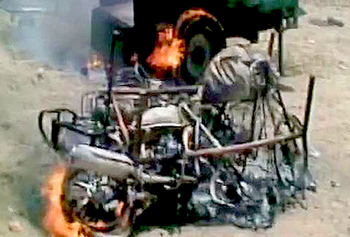Nagaur, May 16: Scores of Dalits have fled their homes in Rajasthan's Nagaur district after four people were killed by Jats, some of them run over by tractors, during a sudden flare-up of violence over a decades-old land dispute.
 Six women of the Meghwal Dalit community women who were seriously injured during the clashes in Dangawas village, 250 km from state capital Jaipur, on Thursday alleged that Jats tried to rape them.
Six women of the Meghwal Dalit community women who were seriously injured during the clashes in Dangawas village, 250 km from state capital Jaipur, on Thursday alleged that Jats tried to rape them.
The dispute revolves round 24 bigahs of land that were mortgaged by a Dalit man 40 years ago for a loan of Rs 1,500. The man's son, 65-year-old Ratanram Meghwal, had approached Jats, the region's dominant upper caste, to give up their claim on the land but they refused.
Tensions spiked on Thursday morning when supporters of Chimanram Jat began moving towards the home of Ratanram Meghwal, which was built on the disputed land. There was a pitched battle when one group tried to occupy the land, said police officer Purna Ram.
Members of the Dalit community too gathered and took position on the roof of Maghwal's house. When the Jats got closer, Meghwal's supporters allegedly opened fire.
This enraged the Jats, and hundreds of them gathered in the choupal (common assembly area) of Dangawas and decided to attack Meghwal's home. Jats armed with guns, axes and other weapons rode dozens of tractors towards the disputed land.
Sources in Dangawas said a war-like situation prevailed in the village as the Jats crushed Meghwal's house with tractors and the two groups exchanged fire.
Three Dalits -- Meghwal, Pokaram and Pancharam - and an OBC man identified as Rampal Gosain died while women were allegedly dragged out of Meghwal's flattened house and beaten.
Reports said some of the Dalits who died were mowed down with tractors. The men on tractors also chased a woman in a bid to crush her. Though the woman evaded the tractors, she was caught by some men and thrashed with sticks, sources said.
Thirteen people, including women, were injured in the clash. The injured were admitted to Jawahalal Nehru Hospital in Ajmer. Officials described the condition of two of them as critical.
One of the injured, Bhanwari Meghwal, who suffered fractures in both legs and arms and had 15 stitches on her head, alleged that two Jat men tore off her blouse and tried to tear her ghaghra (a frock worn by village women) in an attempt to rape her. But she said she had saved herself.
Four more Dalit women - Sonika, Shobha, Badami and Papuri, who are being treated at the hospital in Ajmer - alleged they were mercilessly beaten and molested by Jat men.
"One of them grabbed my hair and dragged me about 50 metres before tearing off my duppata and hitting me on my legs and arms with an iron rod, resulting in multiple fractures," alleged Badami.
Some members of the Dalit community alleged that the Jat men had assaulted the Dalit women and tried to insert rods in their genitals. However, police officers and doctors treating the women denied this claim.
Angry Dalit leaders said they would not take the bodies of dead members of their community from the mortuary unless 13 Jat men named in an FIR were arrested.
The FIR against the 13 Jats was filed at Merta police station on Thursday. However, no arrests have been made so far.
Police officer Purna Ram said four teams had been formed to nab the accused. "We will soon arrest them," he said.





Comments
Add new comment